What is steam engine? It’s a very common question for all of us. In this article, we will learn, the basics, definition, parts, working principle, advantages, disadvantages of steam engines. Let’s explore!
What is Steam Engine? Definition
Steam Engine Basics
Steam engines at earlier stages are not practical to power producers. During the industrial revolution, with more advanced designs they became a major source of mechanical power. As combustion takes place outside the engine cylinder, many steam engines are ‘External Combustion Engines’.
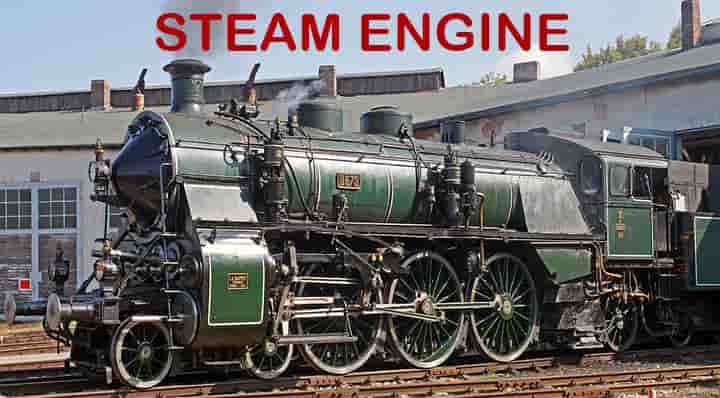
The heat cycle used in the steam engines is the Rankine cycle. It is also called ‘Reciprocating Steam Engine’ as the piston inside the cylinder performs reciprocating motion (To and Fro).
Definition of Steam Engine
It is a heat engine that uses steam as a working fluid to do mechanical work. The steam engines use the force generated by the steam pressure to make the piston move back and forth in the cylinder. This motion is transformed into rotational motion by Connecting rod and flywheel. In this way, steam engines do useful work.
Steam Engine History
In 1781, James Watt applied for a patent for the steam engine, which provided power for various manufacturing equipment. Stationary steam engines are an indispensable part of the industrial revolution. The steam engines can also run traction engines and railway locomotives.
Parts of Steam Engine and Diagram
Let’s see a simple diagram of steam engines, to get simple basic idea of steam engine parts,
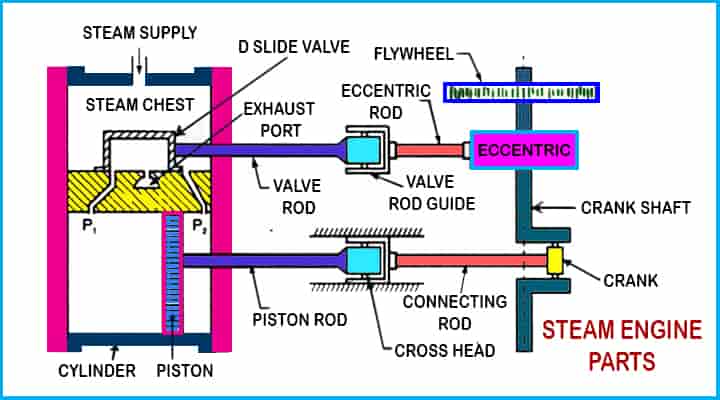
Now, we will see all the parts of the steam engine, in brief, let’s explore! Following are important parts of a single-cylinder reciprocating steam engine,
- Frame
- Cylinder
- Piston
- Steam chest
- D-slide valve
- Inlet and exhaust ports
- Piston rod
- Crosshead
- Connecting rod
- Crankshaft
- Eccentric
- Flywheel
- Governor
- Eccentric Rod and Valve Rod
Let’s try to understand all the parts in brief to have a basic idea of steam engine’s parts.
Frame: The frame is made up of heavy cast iron that supports all the stationary and moving parts. It rests on engine foundations and holds all engine parts in a proper position.
Cylinder: It is a hollow cylindrical container made of cast iron. The piston moves back and forth in the hollow container under steam pressure. Both ends of the cylinder are closed and made steam tight.
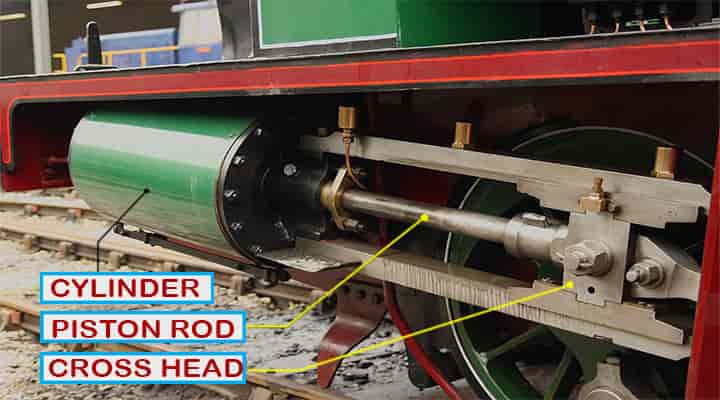
 via Wikimedia Commons
via Wikimedia Commons
Piston: The piston is a cylindrical disc that moves back and forth in the cylinder under the action of steam pressure. Its function is to convert the thermal energy of steam into mechanical work.
Steam Chest: The steam chest is moulded as an integral part of the cylinder. The superheated steam coming from the boiler at high pressure (above 20 Atm.) is fed into the steam chest. This steam is then supplied to the cylinder using a D-slide valve.
D-slide Valve: This valve moves with a simple harmonic motion in the steam chest. It is used to exhaust steam from the cylinder.
Inlet and Exhaust Ports: These ports are used for steam movement in the cylinder body. The steam from the steam chest enters the cylinder through inlet ports. Steam is exhausted through the exhaust port after doing work in the cylinder.
Piston Rod: The piston rod is a round rod, its one side is connected with the piston, and the other side is connected with the cross-head. It transfers motion from the piston to the cross-head.
Cross Head: This is the connection between the piston rod and the connecting rod. It is used to guide the movement of the piston and prevent the piston from bending.
Connecting Rod: Connecting rod is made of forged steel. Its one end is connected to the crosshead and the other the crank. It converts the reciprocating motion of the piston into the rotary motion of the crank.
Crankshaft: This is the main shaft of the engine with a crank. The crank works according to the lever principle and generates the rotational movement of the shaft.
Eccentric: Its function is to provide back and forth to the slide valve. It is made of cast iron and is mounted on the crankshaft.
Flywheel: The flywheel is a heavy cast iron wheel mounted on the crankshaft. It prevents fluctuation of the engine and jerks of the crankshaft.
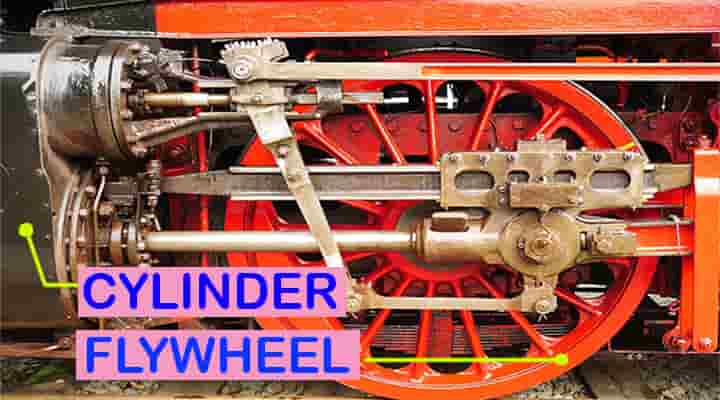
Governor: Governor has the function to keep the speed uniform at varying loads. This is achieved by controlling the amount, or pressure of steam supplied to the steam engines.
Eccentric Rod and Valve Rod: An eccentric rod made of forged steel converts the rotary motion of the crankshaft into the reciprocating motion of the valve rod. The valve rod has the function to provide a simple harmonic motion to the D-slide valve. It connects the eccentric rod and D-slide valve.
Steam Engine Operation
Let’s try to understand how does steam engine works,
- These engines operate on the principle of the First Law of Thermodynamics, stated as heat and work are mutually convertible.
- Steam is produced in the boiler which enters the steam chest through the inlet.
- After the inlet, the steam enters the cylinder through ports, P1 and P1 as shown in the figure.
- The D-slide valve controls the flow of the steam. Its position depends upon the position of the eccentric crank.
- The piston of the cylinder reciprocates due to steam pressure. Here steam expands and part of its thermal energy converts into work by the movement of the piston.
- As the piston is connected to the connecting rods, the piston delivers its power through connecting rods.
- The crankshaft then performs its function and converts the reciprocating motion of the connecting rods into rotary motion.
- Flywheel helps to deliver power at a constant pace.
- From the flywheel final power transfer takes place.
- Expanded steam is allowed to escape through the exhaust port.
- For maximum engine efficiency, this steam can be used to increase the water temperature that will be needed to produce more steam.
Check out a very NICE ANIMATED video from Let’s grow up,
Types of Steam Engines
The steam engines are classified on the following basis:
- According to Number of Working Strokes
- According to the Position of Cylinder
- According to the Position of Cylinder
- According to The Speed of the Crankshaft
- According to the Type of Exhaust
- According to The Expansion of Steam in the Engine Cylinder
- According to the Method of Governing
Let’s see all types of steam engines in brief,
According to Number of Working Strokes
On basis of the number of working strokes, there are two types of steam engines;
- Single Acting Steam Engines: Here steam is allowed to enter from one side of the piston, and only one working stroke is produced during each revolution of the crankshaft.
- Double Acting Steam Engines: If steam is admitted from both sides of the piston, two working strokes are produced during each revolution of the crankshaft. It is said to be a double-acting steam engine. This engine produces double power in comparison to the first engine.
According to the Position of Cylinder
Two types of steam engines according to the position of the cylinder are;
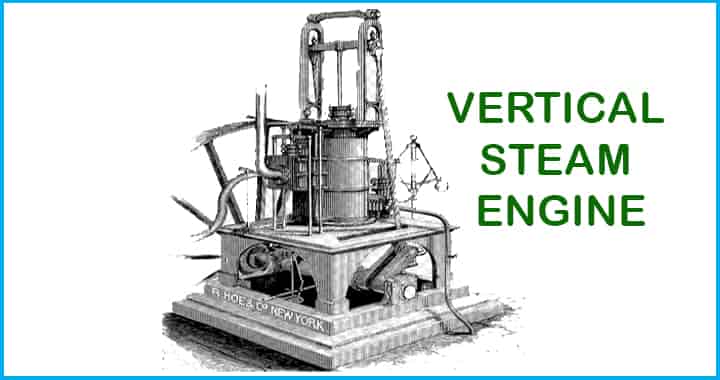
- Horizontal Steam Engines: Here the axis of the cylinder is horizontal.
- Vertical Steam Engines: It has a vertical axis of the cylinder. This engine requires less floor area.
According to The Speed of the Crankshaft
On basis of the speed of the crankshaft, steam engines are classified into three types:
- Low-Speed Steam Engines: Here the speed of the crankshaft is less than 100 rpm (revolutions per minute).
- Medium Speed Steam Engines: It has the speed of crankshaft lies between 100 rpm and 250 rpm.
- High-Speed Steam Engines: This engine has a speed of a crankshaft of more than 250 rpm.
According to the Type of Exhaust
There are two types of steam engines according to the type of exhaust.
- Condensing Steam Engines: A steam engine in which the steam condenses to water at a pressure less than the atmospheric pressure is called condensing steam engines.
- Non-condensing Steam Engines: A steam engine in which the steam doesn’t condense to water and is exhausted into the atmosphere is called a non-condensing steam engine.
According to The Expansion of Steam in the Engine Cylinder
On basis of this criteria, two types of steam engines are;
- Simple Steam Engine: When the steam expansion occurs in a single cylinder and the steam then escapes into the atmosphere or reaches the condenser, this type of engine is called the simple steam engine.
- Compound Steam Engine: When the steam expansion occurs in two or more cylinders, this type of engine is known as a compound steam engine.
According to the Method of Governing
Governing is applied to control the speed of the engine. There are two types of steam engines on the basis of the method of governing.
- Throttling Steam Engine: If a throttle valve is used in the steam pipe to control the engine speed as it regulates the pressure of steam to the engine, an engine with this setup is called a Throttling steam engine.
- Automatic Cut Off the Steam Engine: When we control engine speed by controlling the steam pressure using an automatic cut-off governor, it is called an Automatic cut-off steam engine.
Advantages of Steam Engine
- They are quieter and have fewer vibrations.
- The level of skill required for its operation and maintenance is low.
- They are economical to operate and maintain.
- Steam engines have more lifespan compared to other engines.
- We can easily operate a 100-year-old steam engine of locomotives, on the other hand, it’s harder to operate Internal combustion engines even 20 years.
- Any type of combustible fuel (oil, coal, natural gas, or fuel-wood) can be used.
- A steam engine is a powerful machine, it can run trains to move public and load from one place to another.
Disadvantages of Steam Engine
- The steam engine is huge in size and heavy in weight, therefore requiring more floor space.
- Due to its heavyweight, it cannot be used for running small vehicles like cars and buses.
- It doesn’t start at once. First, we need to produce steam which takes time.
- The most dangerous part of the steam engine is its boiler. This is the area of high pressure and temperature. The boiler can burst due to excessive pressure so safety is a concern in steam engines.
- It has low efficiency due to low steam temperature, also a large surface area is exposed to heat loss.
- More time is spent on its maintenance.
You can get a steam engine model, if you are passionate about it
No products found.
Uses or Applications of Steam Engine
Let’s see the main uses or applications of steam engines,
- In the beginning, steam engines were applied to reciprocating pumps.
- Then rotative steam engines were introduced to drive factory machinery, where conversion of reciprocating motion to rotary motion occurs.
- With the passage of time, steam-powered transport gets started. This includes trains and traction engines.
- In the industrial revolution steam engines were used to run machinery for process work.
- They can be used for agriculture purposes in order to increase the land for cultivation.
- Low power steam engines are used to power steam clocks.
Efficiency of Steam Engine
We can get the efficiency of the steam engines by dividing the energy output in the form of mechanical work on input to the engine by burning fuel. Efficiency of Steam Engines = Energy output in form of mechanical work/ energy input by burning fuel
How to achieve Greatest Efficiency?
To achieve the greatest efficiency, the steam temperature should be the highest possible (superheated steam), and the exhaust of waste heat should be at the lowest temperature possible. Higher efficiency is also possible if the steam expands to lower pressure and temperature in the steam engines.
- Practically, steam engines have very low efficiency (1 to 10 percent), we can improve it to 25 percent by adding a condenser and adopting multiple expansion.
- This means steam engines with condensers are more efficient than steam engines without them.
- In the case of locomotives steam exhausted from the atmosphere is wasted.
For a power station with steam reheat and economizer, the thermal efficiency can be increased up to 40 percent. If we use waste heat for heating by utilizing cogeneration, we can make input energy useful by as much as 85 to 90 percent.
Safety of Steam Engines
Steam engines consist of some critical parts like boilers and pressure vessels. They contain a huge amount of potential energy. The explosion of these components can cause damage to human life and property. In the past, a lot of accidents were caused due to the explosion of the boiler. Failure modes include over-pressurization of the boiler, faulty design, poor material, insufficient water in the boiler, and pressure vessels may fail due to inadequate construction or maintenance.
- Therefore, the safety of steam engines should be taken care of.
- The steam engine should be regularly maintained and looked after.
- No risk should be taken to keep the engine running if any unusual behaviour is noted.
- Components need to be properly designed and constructed.
- Strong materials should be used that can withstand high pressure.
- Use of lead plugs to prevent boiler explosion, if the water level drops, the lead melts and steam escapes. In this way, the boiler will not overheat.
- To enhance safety measures, any incidents or accidents occurred should be timely reported.
Conclusion
This is a brief introduction to the steam engines. If you have any queries regarding any part of this topic, feel free to contact us. We will love to answer. To keep learning, click here to completely understand boiler mountings, it’s working, function, and construction. Check out our nice articles,
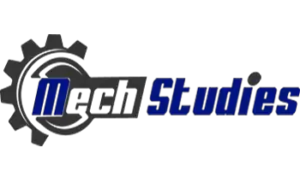
I like that you talked about how a steam engine is a heat engine that uses steam as a working fluid to do mechanical work. I was watching a documentary about the history of manufacturing and I noticed that steam has been used for quite a long time now. From what I’ve seen, it seems there is a lot of steam equipment available nowadays, like a steam generator for example.
This is a good tip particularly to those fresh to the blogosphere. Simple but very precise information… Appreciate your sharing this one. A must read article!